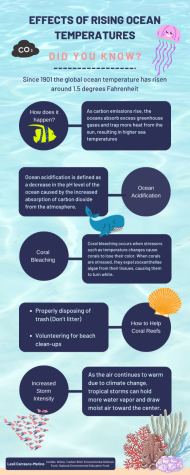Global ocean temperatures are rising, with devastating consequences for the entire planet
As human carbon emissions rise, releasing massive amounts of greenhouse gases into the atmosphere, the planet is warming at an ever-increasing rate, posing a serious threat to the ocean and marine life. In fact, the global ocean temperature has risen around 1.5 degrees Fahrenheit. While many may not think it’s a big deal, even a small increase in water temperature can have devastating consequences for the world.
Over 70 percent of the Earth’s surface is covered by oceans. When carbon dioxide emissions rise, the oceans absorb excess greenhouse gases and trap more heat from the sun, resulting in higher sea temperatures. In addition to ocean warming, the ocean’s pH is decreasing. This is referred to as ocean acidification. It is caused by excess carbon dioxide dissolving in the ocean, lowering the acidity of the ocean. Ocean acidification is particularly damaging to marine life because it causes coral bleaching and prevents the formation of shells and skeletons in certain sea animals.
One of the many devastating consequences of global warming is coral bleaching. Coral bleaching occurs when stressors such as temperature changes cause corals to lose their color. When corals are stressed, they expel zooxanthellae algae from their tissues, which causes them to turn white. Bleaching weakens corals, making them more susceptible to disease and higher mortality rates. Extreme bleaching causes them to die.
According to the NOAA (National Oceanic and Atmospheric Administration), nearly 25 percent of all marine species are found in, on, and around coral reefs, making coral bleaching a particularly catastrophic consequence of climate change. With millions of species depending on reefs for survival, bleaching threatens to wipe out entire ecosystems. Additionally, coral reefs also play an important role in protecting coastlines and humans from storms, floods, and erosion.
Recent research has found that mass coral bleaching events have become five times more frequent around the planet over the last 40 years, according to an article on Carbon Brief.
 “All coral reef regions of the world are now experiencing more frequent severe coral bleaching events,” Royal Society University Research Fellow and Chair of Marine Ecology at Lancaster University Nick Graham told Carbon Brief. “Critically, the time between bleaching events is now as short as six years, which is insufficient time for full recovery of coral cover on damaged reefs.”
“All coral reef regions of the world are now experiencing more frequent severe coral bleaching events,” Royal Society University Research Fellow and Chair of Marine Ecology at Lancaster University Nick Graham told Carbon Brief. “Critically, the time between bleaching events is now as short as six years, which is insufficient time for full recovery of coral cover on damaged reefs.”
In addition to coral bleaching, warmer ocean temperatures cause stronger tropical storms with higher wind speeds, increased flood risk, and heavier rainfall.
“Evaporation intensifies as temperatures rise, and so does the transfer of heat from the oceans to the air. As the storms travel across warm oceans, they pull in more water vapor and heat,” according to the Environmental Defense Fund. “That means stronger wind, heavier rainfall and more flooding when the storms hit land.”
Stronger hurricanes can have a devastating effect on the socioeconomic health of the areas they hit. Their increased severity could result in numerous deaths and significant property damage that could cost millions of dollars to repair, forcing many to relocate.
Human-induced global warming is directly responsible for ocean warming and its effects. Composting food scraps or leftovers, turning off the lights when leaving a room, and recycling are excellent ways to fight climate change at home. You can help protect and save coral reefs by properly disposing of trash and not littering, volunteering for beach cleanups, and reducing the use of fertilizers and pesticides that contain chemicals that harm coral reefs.
Your donation will support the student journalists of Parkdale High School. Your contribution will allow us to cover our annual website hosting costs and publish some printed editions, as well.

Lesli Carrasco-Merino is a junior at Parkdale, and this is her first year on The Paw Print staff as a reporter. She aims to provide informative articles...







